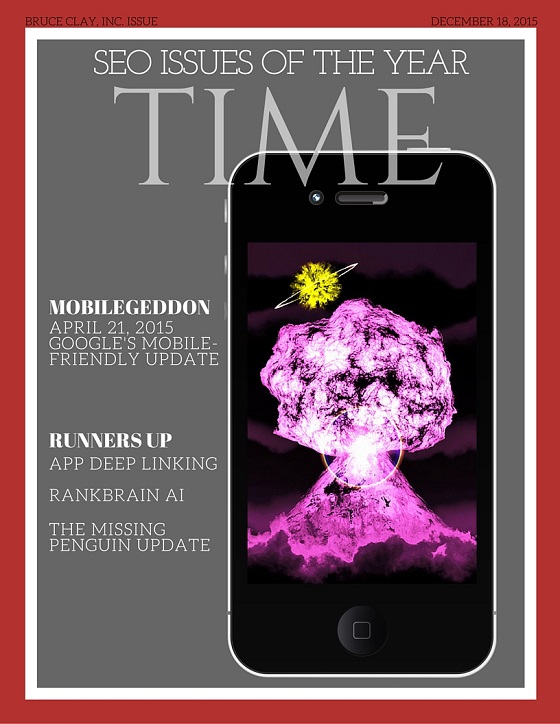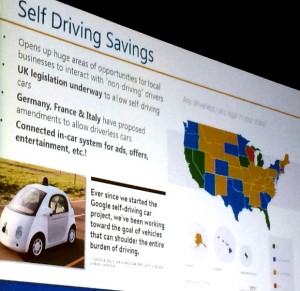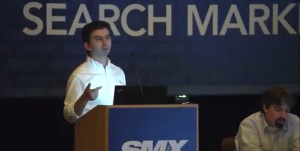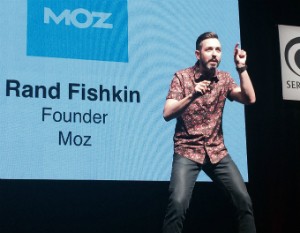SEO in 2015: A Retrospective for the Introspective – Virtual Conference Recap was originally published on BruceClay.com, home of expert search engine optimization tips.
If you’re the kind of person who follows SEO industry news closely, you may tend to glance over year-end retrospectives. But, there’s a chance you haven’t taken a personalized approach to an SEO year in review. Take a look at the year’s most shared and viewed SEO conference liveblogging as a growth exercise. Go through 2015’s game-changing SEO conference presentations, and consider what you plan to do to become better in 2016.
Standout SEO Presentations of 2015
If TIME Magazine were to do an issue on the SEO industry in 2015, the table of contents would look like this.
2015 SEO Story of the Year: Mobilegeddon
Runner-Up: More Mobile – App Deep Linking and Indexing
Runner-Up: The Penguin that Never Came
Runner-Up: RankBrain AI
15-Minutes-of-Famers in 2015: Millennials are the moment’s hottest market segment, but it’s an attention to audience that has staying power

We don’t publish TIME Magazine, but on the BCI blog, we do publish the SEO industry’s major news stories and marketing practices. A mobile-focused marketing perspective, Google’s MIA Penguin and link removal practices, and a search engine ranking algorithm that learns are the topics covered on today’s Virtual Conference SEO track.
First, a keynote to set the stage.
The Future of Search

Forrester’s facts about self-driving cars, including map of states where it’s legal (above)
Duane Forrester is a futurist. A futurist studies predictions and possibilities about the future of life and society. Forrester’s Pubcon Las Vegas keynote in October was one to watch. The Microsoft search insider draws a roadmap for search, technology, and the digital marketing industry. Here are the looming landmarks.
- Millennials, baby. They’ve got spending power. They’re uber connected. They’re the Internet’s reigning kings. Does your business cater to them? (Step 1: Figure out what that even means for your business.)
- Mobile’s the word. The majority of web traffic is mobile, you know. Starbucks is a shining example of a brand that’s adapted to mobile. In the U.S., 11% of Starbucks transactions (order, pay, tip, get rewards, locate stores) happen with the company’s mobile app. Expect to see mobile payment becoming the norm in years to come; Apple Pay and other secure, phone-conducted commerce apps are about to blow up. Another growth area of mobile commerce is the rise in affinity programs. Starbucks turned being their customer into a community experience.
- Self-driving cars rise. What would you do if your commute time became productive time? But don’t expect to get that found time for free. Self-driving car are also vehicles for captive audience advertising.
- Machine learning is real. Computer processing resources have finally reached the level of efficiency needed to let the computers learn for themselves at large scale. We’re seeing machine learning at work in applications that predict winners of political races and sporting competitions, and software that recognizes faces along with age and gender. Search engines are putting machine learning to work to improve the quality of ranking algorithms, as we learned later this year when Google confirmed the existence of RankBrain; more on that below.
- Digital butlers, aka agents, at your service. Here is the future of search. Search wants to bridge user intent and the experiences the world (businesses, organizations, communities, governments) has to offer. A digital agent will do your bidding and proactively find ways to satisfy your tastes and preferences. Duane’s real-world examples are included in the full presentation liveblog.
- Your data is showing. Everyone reading is leaking data at a startling rate. Data is a commodity that is collected. Duane calls data the new oil.
Read our liveblog coverage of Duane Forrester’s Pubcon Keynote on the Future of Search to look closely at each of these revolutionary stops on the search roadmap.
Since this keynote, Duane was announced as the new VP of organic search operations at BCI. If you want to work with the former Bing search industry spokesperson, partner with the digital marketing agency dream team.
Next, the 2015 search marketing conference sessions that get into the nitty gritty.
Mobile SEO Everything

Google’s Gary Illyes at SMX East
April 21, 2015, the infamous Mobilegeddon, was the date felt round the SEO world. It was the date that Google announced would officially usher in mobile-friendliness as a ranking signal. Five months later, at SMX East, Google Webmaster Trends Analyst Gary Illyes shared “3 Things Google Wants You to Know about Making Websites Mobile Friendly.” Here he talks about the properties of a web page Google uses to judge mobile-friendliness. He talks about app indexing and how to get your app to show up in Google SERPs. And he explains the significance of predictive search app, Google Now, and its key characteristics: voice search and the tap-to-search feature Now on Tap.
In this same session, Stoney deGeyter does a deep dive of mobile SEO, from mobile configuration to common mobile website mistakes. Marcus Tober wraps up the session by sharing a study of mobile ranking factors.
Read it all in our liveblog coverage of Getting Mobile Friendly to Survive the Next Mobilegeddon.
Mobile apps are a big piece of the conversation around mobile SEO and mobile marketing. On this topic, you’ll want to review presentations by Google Webmaster Trends Analyst Mariya Moeva, Emily Grossman and Igal Stolpner. Moeva overviews Google’s documentation on how to get your mobile app (both Android and iOS apps) in the search engine’s index. Grossman builds on Moeva’s recommendations with tips for setting up your domain, app and server for Google indexing. Stolpner provides context for the app indexing conversation with case studies and stats that show how app indexing can benefit a business.
Read all these presentations in our liveblog coverage of SMX East’s Beyond the Web: Why App Deep Linking Is the Next Big Thing.
Not to be overlooked in a mobile SEO and marketing conversation, Apple is a big player with a different set of optimization rules than Google. Grossman is an Apple search and iOS app specialist, who shares her tips for optimizing brand visibility on Apple’s technology stack in the SMX East session How Apple’s Changing Up Search: From Siri to Safari to Spotlight. With 3,000 iPhone sales a minute, be sure not to pass over Apple opportunities.
Link Building Tactics in the Penguin Age
The Google Penguin update that was highly anticipated but never came in 2015 was a major SEO story. The Penguin update expected to pardon reformed link spammers is still ahead, while SEOs continue to do link clean-up while sharing link audit best practices with others. Megan Geiss outlines the link removal process. Sha Menz promotes the penalty recovery power of the Google disavow file. And Eric Enge gives marketers a link building attitude adjustment with content marketing inspiration.
Read all the expert’s link building and clean up tips in our liveblog coverage of SMX East’s Link Building, Auditing and Removal.
SEO in the Machine Learning Environment
2015 was the year for AI IRL. Machine learning, a process where a computer teaches itself, is a type of artificial intelligence. And, Google says it uses a machine learning ranking algorithm called RankBrain. So yes, the future has arrived. What does Google’s AI algorithm mean for search engine optimizers? Two pertinent points to note from the year’s liveblog coverage.

Rand Fishkin on stage at Pubcon Las Vegas
First, you must account for and optimize for engagement ranking factors. In Rand Fishkin’s Pubcon keynote, we read that there are the traditional SEO optimization factors we have always accounted for: ranking inputs such as keyword targeting, quality and uniqueness, crawl/bot friendliness, snippet optimization, UX/multi-device optimization. Additionally, machine learning demands that SEOs optimize for searcher outputs such as CTR, long-clicks, content gap fulfillment, amplification and loyalty, task completion success.
Get all the information in our liveblog coverage of SEO in a Two Algorithm World.
Second, keyword research and keyword optimization have evolved. Craig Paddock describes the shift from a keyword focus to a content and topic oriented research mindset. He shares lots of tools and research starting points. Ash Nallawalla gives content writers a spreadsheet for documenting keyword competitor research from which you can select your organization’s winning phrases. Bruce Clay adapts the traditional SEO keyword research and optimization process to today’s semantic search analysis and voice search query behavior.
Read it all in our liveblog post of the Pubcon session Keywords and Keyword Research.
Bonus SEO Topics: Business Operations and Q&A
Worth mentioning are a couple sessions that don’t fit cleanly into our above story arch but which you might find an insightful read.
If you’ve ever wondered how your SEO operation might scale, read about how to grow a successful SEO agency from the Pubcon coverage of Building an SEO/SEM Agency.
The always popular AMA (ask me anything) style session, when SEOs can ask search engine reps their pesky optimization questions, hits many topics including the Knowledge Graph, AJAX and JavaScript crawling, social signals as ranking factors, content syndication best practices, HTTPS, and authorship markup. Read Gary Illyes and Duane Forrester’s thoughts on these topics and more in liveblog coverage of SMX East’s Meet the Search Engines.
No comments:
Post a Comment